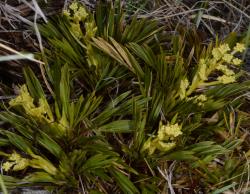- Taxon
- Gallery
Leaf rosettes up to 20 cm diameter in groups of up to 10 or more, sometimes rhizomatous. Leaves coriaceous, grey-green, sometimes yellowish, up to 18 cm long, mostly 4 - 5 pairs of leaflets, tending to be folded upward; sheath up to 70 × 12 - 2.5 mm, sheath joint usually evident; stipules much shorter than to almost as long as the petiole, up to 30 × 0.6 mm, petiole up to 40 × 2 mm, flat to convex above, margins rounded to acute, pulvinus obscure, 1 — 2 mm long; lamina ± rhombic in outline, lowermost leaflet up to 50 × 2 - 3 mm, apex acute with a spine c. 1 mm long, midrib obscure to 0.2 wide, marginrib c. 0.2 mm wide, ribs and veins often raised and prominent. Inflorescences of broad type. Female inflorescence up to 300 mm long, with a stem 200 × 3 - 4 mm, brown to green; head 60-80 × 40 mm, more or less ovate in outline; compound umbels 4 - 8, usually arranged in 2 - 3 whorls, the terminal umbel larger than the lower laterals; lower bracts c. 30 mm long with a sheath c. 20 × 2.5 mm, stipules, and one leaflet pair; upper bracts smaller and simple with stipules. Lower compound umbels up to 30 mm long with peduncles up to 20 × 1 mm, primary bracteoles simple, up to 10 × 1 mm; simple umbels up to 5 with peduncles up to 6 × 0.5 mm; secondary bracteoles simple, up to 7 × 1 mm; up to 10 flowers per umbel with pedicels up to 2 × 0.2 mm. Sepals up to 0.9 mm long; petals up to 1.1 × 0.5 mm, not inflexed; staminodes up to 0.3 mm long. Mericarps dark to pale brown, dull, up to 4 × 2 mm, rarely longer, with a style up to 1.1 mm long; lateral ribs up to 0.3 mm wide. Male inflorescence up to 240 mm long, with a stem 150 × 3.5 mm, green to brown; head 90 × 50— 70 mm, ovate to circular in outline; compound umbels 5 - 7, tending to be in 2 - 3 whorls, the terminal umbel larger than the lower laterals; bracts similar to those of the female; lower compound umbels up to 50 mm long, with peduncles up to 35 × 1.5 mm; primary bracteoles up to 20 × 1.5 mm; up to 10 simple umbels with peduncles up to 10 × 1 mm; secondary bracteoles up to 8 × 0.5 mm; 10—15 flowers per umbel with pedicels up to 3 × 0.1 mm. Sepals up to 1 mm long; petals up to 1.1 × 0.6 mm, not inflexed; stamens up to 2.1 mm long.
[Reproduced from Dawson (1979, New Zealand J. Bot. 17: 339-351) with permission from The Royal Society of New Zealand.]




